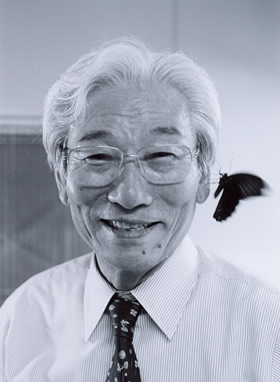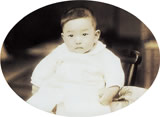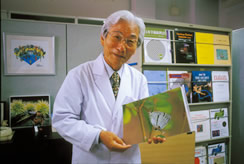 |
| From biology to biochemistry |
 |
 |
When I was in primary school, a teacher showed me how to raise cabbage butterflies. I developed a passion for it, and my home became filled with caterpillars, even when I was evacuated from the city during the war. During my years in junior high school and high school, knowledgeable older students taught me the basics of natural sciences. I preferred raising butterflies to collecting rare specimens. That was my own way of coming in contact with living creatures.
I intended to go to Kyoto University’s School of Agriculture and become an entomologist, but during a school trip we stopped by Akamon and Sanshiro Pond. They left an impression on me, so I went to the University of Tokyo instead. One of my classmates was Ken’ichi Matsubara, a professor emeritus at Osaka University and the president of DNA Chip Research Inc. We were kindred spirits with an interest in pursing studies in biology. I couldn’t stand chemistry, and had to take makeup tests, but in one course, I learned that biochemistry studied the connection between living creatures and substances. I then sensed a fresh appeal in the subject, and switched my major to chemistry. |
 |
| Encounter with the bacillus subtilis genome |
 |
 |
In graduate school, I became affiliated with the forerunner of the Institute of Molecular and Cellular Biosciences. There was an interdisciplinary atmosphere created by people specializing in science, agriculture, and pharmacology, but the professors and associate professors also had regular jobs, and most of them were usually not present. The assistants and the students set up what was called the Free Area and planned their own research. That’s when I encountered the bacillus subtilis.
At that time, it was one of the few organisms that could incorporate DNA from external sources. Noboru Sueoka of the University of Illinois, now a professor emeritus there, invited me as a post-doctoral fellow.
As my background was in biochemistry, I was inclined toward proteins, but Sueoka, who was one of the last students of the botanical geneticist Hitoshi Kihara, was already thinking of genome research at that time. When I showed Sueoka a paper that asserted proteins could be created from the edges, he suggested that in the same way, the genome DNA was the starting point for reproduction. If we could find some markers on the genome, the cells at the markers near the starting point would soon double once DNA reproduction began. On the other hand, the markers at the point furthest away would be the last to double.
It was very difficult to see whether the volume of substances in the organism doubled, but with the bacillus subtilis, which creates spores, we could measure the DNA volume when reproduction had stopped. When we examined the DNA taken from a fungus body that has begun to multiply, we found that the sequence in which each marker doubled was already determined. The genome DNA was reproduced in a well-regulated, overall order. |
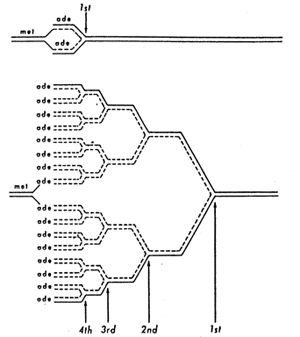 |
Upper: Genome DNA reproduction in the bacillus subtilis. Reproduction always starts at a predetermined point. "ade" and "met" are markers discovered on the genome DNA.
Lower:When the speed of cell division surpasses that of reproduction, reproduction sequentially arises from the starting point before reproduction is concluded, as shown in this representation. This is called the "Dragon of Yamata". |
 |
Genome research from the point at
which reproduction begins |
 |
 |
After working independently with my own lab, I began to focus on the universality and diversity of the phenomenon of the start of reproduction. The basic sequence for the start of reproduction is the same for both the bacillus subtilis and intestinal bacteria. This activity is conducted in a small area for the intestinal bacteria, but is dispersed for the bacillus subtilis and is the mechanism for controlling the start of reproduction. There is a difference between intestinal bacteria, which multiply at a furious rate, and the individuality of the bacillus subtilis, which make spores and then rest.
Research into prokaryotes cannot observe the diversity using intestinal bacteria alone. Therefore, the bacillus subtilis genome project was launched as a joint international research effort, in which the researchers could freely use the information on the bacillus subtilis.
Yeasts, which are eukaryotes, differ from prokaryotes in that there are multiple points for the start of reproduction in the chromosomes. Examining them individually yields no clues to the reasons for this multiplicity. Looking at the chromosome as a whole, however, shows that these starting points are not distributed evenly, but rather are scattered. Reproduction begins from a starting point near the center and then proceeds to the edges in sequence. We discovered that the scattering of the starting points acts as a brake when abnormalities occur in the DNA composition. This is the means used by eukaryotes to reproduce chromosomes without error. |
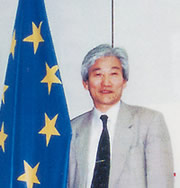 |
Dr. Yoshikawa went to EU headquarters in Brussels by himself to obtain funding for the bacillus subtilis genome project in Europe. |
 |
| The youthful entomologist and molecular biology |
 |
 |
When I graduated from primary school, I experienced life in postwar Japan. My days as a university student coincided with the domestic unrest over the security treaty with the United States, and I studied in the United States during the Vietnam War. Therefore, I have seen social unrest first hand. I have considered my responsibility to society as a scientist, and sometimes been perplexed at how to apply my sense of justice. I was part of the legal team for the plaintiff in the SMON lawsuit when I was at Kanazawa. I argued that the dispersion of agrichemicals to protect the pine trees killed insects unrelated to the problem. I also was involved with the founding of the Molecular Biology Society of Japan to promote DNA research in this country. I’ve done whatever I could wherever I happened to be at the time.
The best thing about founding the Molecular Biology Society was creating the Insect Group with other people who were interested in insects in their youth, including Syozo Ozawa, a former advisor at the JT Biohistory Research Hall. Tokindo Okada, a former director of the Hall, heard that we had formed an Insect Group and visited me. He told me he wasn’t interested in the Society, but wanted to join the Insect Group. We had a really good conversation about butterflies. That’s how I, who had been interested in insects as a youth, rekindled my interest in molecular biology. I am excited that I am able to be involved with new projects with young people.
(Text: Atsushi Yamagishi) |
|
 |
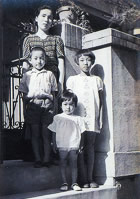 |
 As a first year primary school student. My mother, sisters, and I in front of our home in Kobe. As a first year primary school student. My mother, sisters, and I in front of our home in Kobe. |
 |
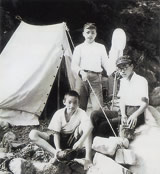 |
 Collecting insects as a high school student (I am on the left) Collecting insects as a high school student (I am on the left) |
 |
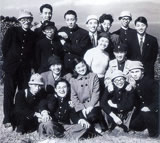 |
 I went to the University of Tokyo to study chemistry in the School of Science. One of my classmates was Ken’ichi Matsubara. (Second from the left in the back row. He is a professor emeritus at Osaka University, and also the president of DNA Chip Research Inc. I am fourth from the right in the back row.) I went to the University of Tokyo to study chemistry in the School of Science. One of my classmates was Ken’ichi Matsubara. (Second from the left in the back row. He is a professor emeritus at Osaka University, and also the president of DNA Chip Research Inc. I am fourth from the right in the back row.) |
 |
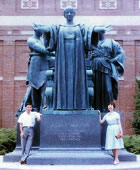 |
 During my studies at the University of Illinois. With my wife in front of the Alma Mater statue, the symbol of the university. During my studies at the University of Illinois. With my wife in front of the Alma Mater statue, the symbol of the university. |
 |
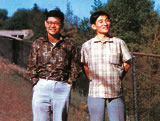 |
 |
 I began research into the reproduction of the bacillus subtilis in the laboratory of Noboru Sueoka, now a professor emeritus at the University of Colorado. I began research into the reproduction of the bacillus subtilis in the laboratory of Noboru Sueoka, now a professor emeritus at the University of Colorado. |
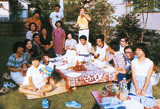 |
 At a barbecue party at my home with colleagues from the Kanazawa University Cancer Research Institute At a barbecue party at my home with colleagues from the Kanazawa University Cancer Research Institute |
 |
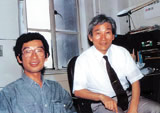 |
 With my right-hand man in bacillus subtilis research, Naotake Ogasawara, at the Osaka University Medical School’s Genetics classroom, currently a professor at the Nara Institute of Science and Technology. With my right-hand man in bacillus subtilis research, Naotake Ogasawara, at the Osaka University Medical School’s Genetics classroom, currently a professor at the Nara Institute of Science and Technology. |
 |
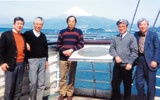 |
 My colleagues in Japanese genome research. From left, Yoshiyuki Sakaki, head of the Riken Genomic Sciences Center; Ken’ichi Matsubara, Asao Fujiyama, professor at the National Institute of Informatics; Mitsuaki Yoshida, the head of Banyu Pharmaceutical’s Tsukuba research lab, and me. My colleagues in Japanese genome research. From left, Yoshiyuki Sakaki, head of the Riken Genomic Sciences Center; Ken’ichi Matsubara, Asao Fujiyama, professor at the National Institute of Informatics; Mitsuaki Yoshida, the head of Banyu Pharmaceutical’s Tsukuba research lab, and me. |
 |
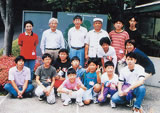 |
 As a budding entomologist, I enjoyed trips during summer vacation with primary school students. (Mt. Ikoma: At the Cosmos Seminar) As a budding entomologist, I enjoyed trips during summer vacation with primary school students. (Mt. Ikoma: At the Cosmos Seminar) |
|
